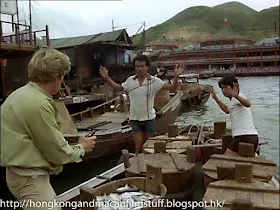Is it Yau Ma Tei or Kwun Chung? I think the former as this location is on the north side of Jordan Road whereas Kwun Chung seems to mainly occupy the southern side (I bet most of you are wondering where on earth Kwun Chung is - it's the proper name for the area generally referred to these days by its MTR station: Jordan.
Never mind, this is actually a great piece of detective work by Thomas, so many thanks to him for once again coming through and pulling this one, seemingly, from nowhere. The shot is just one of several scene setting short shots that establish HK as the location for the following bit of film, and as we already mentioned on previous blog posts for this film, the director had been barred from filming and was told to leave HK a.s.a.p due to the politically charged nature of the film (let's just say it shows Chinese Communism for exactly as it is/was). So, I imagine this small shot was taken sneakily, I'm just a bit confused as to why this particular piece of Kowloon made it into film as opposed to any other.
Amazingly (or not) most of the buildings in this screen grab can still be seen today (or at least they can on the current version of Streetview which, I believe, is about 5 years old now). Here's the modern view. I'm wasn't convinced as much by the building on the left hand side, but after checking on Centamap, it is indeed also the same block as seen on film - the three closest blocks all being built in 1966 and the one with the angled front (far right in the screen cap) was actually built in 1960.



















































